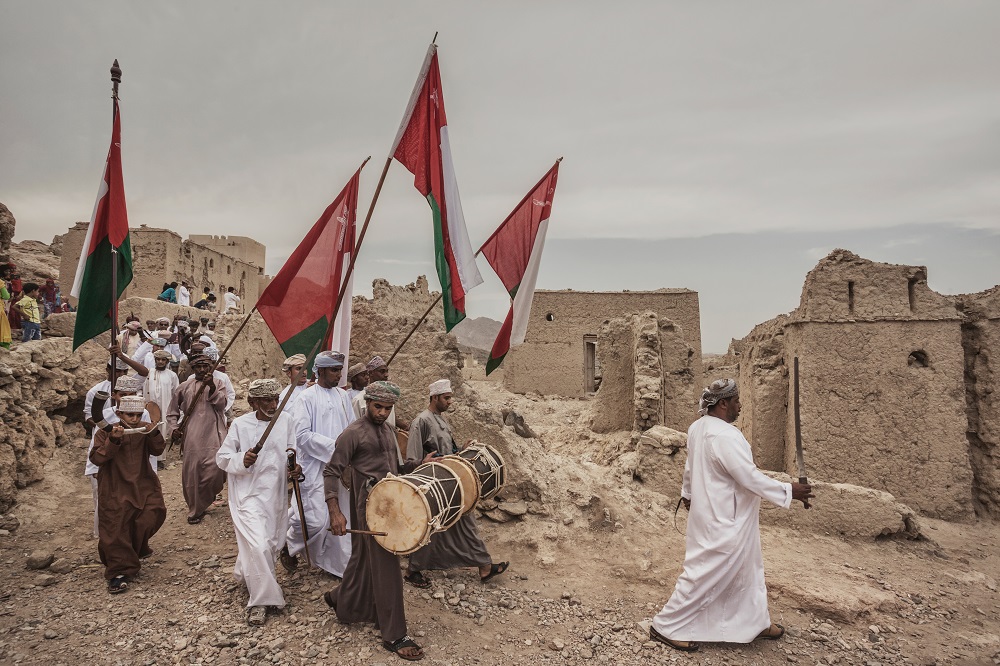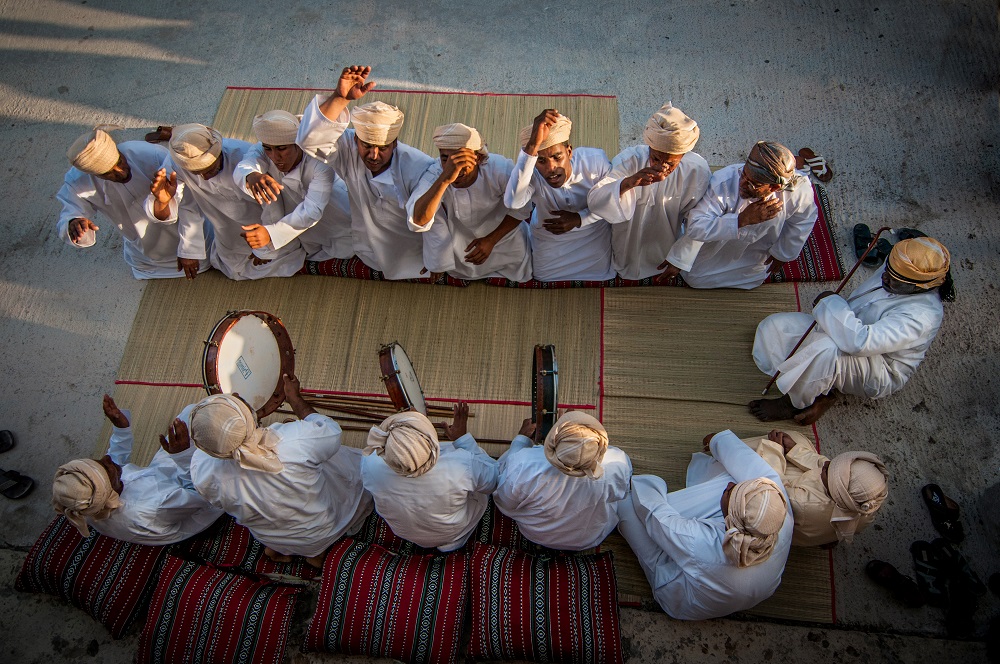Music in Oman: A Brief History of the Practices and the art of 'Al-Mawlid'
Rahma Al Kalbani
There is no doubt that music was and remains an important element in Omani life, as a social practice and even as a diplomatic tool. Classical music is rarely associated with Oman unless it is Arab music, and most musical arts are related to some form of dance and expressive movements, which are in harmony with the reason for this musical art.
Music has always expressed an Omani individual’s joys and sorrows, home and travels, health and illness, and life and death. This explains the tremendous amount of Omani traditional music documented by the national project for preserving the Omani musical heritage. In this article, we offer a brief historical overview of the development of interest in Omani music at both the institutional and attention levels, and then we review a traditional Omani piece of music: the art of the “Al-Mawlid.”

Oman possesses a musical heritage linked to its historical legacy, as many of the pieces of music that are known today have Omani roots, but they were formed through cultural contact with different civilizations around the world. The government has preserved Oman’s musical heritage through numerous national projects, government programmes (including education), and community initiatives. In addition to this, the community contributes to preserving Omani music through practice in social life or academic study, as well as working in the music field.
The first established musical band in Oman was in 1972 in Muscat, and a second was established in Salalah the following year. These were military musical bands and their members were mainly Omani boys between 14 and 16 years old. Then the formation of military bands progressed to include all the military sectors, so there were bands for the Royal Army, the Royal Air Force, the Royal Navy, the Royal Guard, and the Royal Oman Police. The last two sectors’ musical bands are among the best in the world.
In 1983, His Majesty Sultan Qaboos bin Said ordered the implementation of the traditional Omani musical heritage preservation project. Before this, Oman's traditional music was only preserved orally by its practitioners, so it was an important and dynamic project which continued until 1984. It was followed by the organising of the International Symposium of Omani Traditional Music in 1985. The importance of that symposium lies in introducing the Omani traditional music after its documentation. In the same year, the Oman Centre for Traditional Music established as a research reference, and a platform for national initiatives in the field of Omani traditional music.

Western music has been paid special attention in Oman for two reasons: the personal attachment of His Majesty the Sultan, and the role of music in building bridges of peace, cooperation, and in welcoming others. There have been many initiatives in this regard, such as the formation of the Royal Oman Symphony Orchestra in 1985, the prominent opening of the Royal Opera House in 2010, and then the opening of the House of Musical Arts in 2019. The interest in Arab music was already wide-spread in Oman, and interrelated with the interest in Omani and Western music, as Arab music is an extension of cultural contact and common heritage. This can be noted in many musical compositions played by the Omani bands.
The establishment of these institutions and musical bands would not be nearly as significant without the presence of practitioners, who hold recognised degrees in practicing music of all kinds. After a period of time, when practicing music became widely accepted by Arabs and foreigners, Omanis started practicing music. Music was then included in schools’ basic education curricula, and another leap was taken in the field of music when the Department of Music and Musical Sciences started its academic programme at Sultan Qaboos University in September 2008.
Community initiatives also had an important role, most notably the recognition of Oman Oud Hobbyist Association. Furthermore, the recent formation of the Ministry of Arts in 2019 is a sign of the completion of the musical institutional practice in Oman.
However, an important factor in the present and the future of music in Oman remains the audience, especially the Omani audience. In 2016, I conducted my Master’s degree on the audience of Western classical music in Oman. The aim was to identify the socio-demographic characteristics of the Omani audience, and to be acquainted with the presence of the traditional Omani musical heritage in performances of one of the largest theatres in the Arab world, Oman’s Royal Opera House. I was motivated to pursue this research because this particular field suffers from a severe shortage of research, if not neglect, by those studying the sociology of music.
Juma Al-Shidi is one of the Omani specialists and key researchers in Omani traditional Music. In January 2014 he wrote an article in the “Al-Watan” newspaper about “the art of Al-Mawlid", a religious ritual and an art. The art of “Al-Mawlid” consists of repeating phrases that mention Allah and the prophetic praise in commemorating the noble Prophet’s birthday. "Al-Mawlid" means “the birth", which was originally held to celebrate the birth of the Holy Prophet (PBUH). The most famous in Oman is "Mawlid al-Hawamah" or "Arabian Mawlid", as they call it to differentiate it from other types such as "al-Barzanji", "al-Bahrani", and "al-Badie", which are names given to a specific type of religious folk art, usually spread in the north of Al-Batinah in Oman.
In "Mawlid al-Hawamah", the group that performs this type of “Mawlid” is called a “circle” and consists of:
- the caliph: the head of the circle
- the caliph’s deputy: his representative in his absence
- "Al-Shawawsh": informs the members of the “circle” about the place and the time of conducting "Al-Malid" and other related matters
- “El-Haw'wimah": men who perform the movement.
The "Mawlid" art is performed as follows: two rows of men sit opposite each other and are “the readers” and "El-Haw'wima”. During the performance, everyone in the readers' row stands on their knees and leans on their sticks, swaying their bodies and heads right, left and forward, and they sit after singing each of the two verses of poetry. As for the movement of "El-Haw'wima", it is an overlapping and interconnected movement. Each person wraps their left arm round the back and waist of the person sitting to his left, and the performers conduct a mixture of movements, such as swaying to the right and left, forward and backward, then prostrating, waving their hands, and hitting the ground or their chest and clapping. The performance of "El-Haw'wima" is sometimes accompanied by a tambourine percussion (a rhythmic instrument) at the beginning or end.
In terms of the poems that are performed as part of this art, they are diverse, and include passages such as:
| sllu ealaa khayr al'anami, muhamad min midarin ma nah waraq alhamam ealaa ghusun alshajar ya min hawah 'aqam fi mahjati waistaqara etfaan ealaa almustaham bikum halif alsahr damaei kafid alghamam min faqad bahi algharar min fireih kalzalam wawajhah kalqamar |
صلّوا على خير الأنام محمد من مضر ما ناح ورق الحمام على غصون الشجر يا من هواه أقام في مهجتي واستقر عطفاً على المستهام بكم حليف السهر دمعي كفيض الغمام من فقد باهي الغرر من فرعه كالظلام ووجهه كالقمر |

Discussing what has been accomplished in the field of music in Oman is easy now, but things haven’t always been this way. In a conservative Islamic country, talking about music, without even practicing it, faced many difficulties. However, successes were achieved due to the efforts of those involved in the field in creating a musical base, audiences, and researchers interested in developing and expanding musical participation in the social life of Oman.